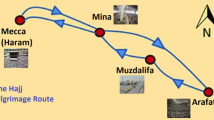Abstract
Human trafficking is a global issue of the world and the problems related to human trafficking remain unsolved. This paper presents a new method for the identification of photos of different types of families and non-families such that the method can assist investigation team to find a solution to such issue. We believe that parts of human beings are the main resources for representing family and non-family photos. Based on this intuition, we propose to segment hair, head, cloth, torso, and skin regions from each human in input photos by exploring a self-correlation for human parsing method. This step results in region of interest (ROI). Motivated by ability of deep learning models in solving complex issues and special property of MobileNet, which is light weight model, we further explore MobileNetv2 for the identification of photos of different families and non-families by considering ROI as the input. For the experiment of this work, we consider a dataset of ten classes, which include five family classes, namely, Couple, Nuclear Family, Multi-Cultural Family, Father–Child, Mother–Child and five more non-family classes, namely, Male Friends, Female Friends, Mixed Friends, Male Celebrity, Female Celebrity. The results of the proposed method are demonstrated by testing on our dataset of family and non-family photos classification. Comparative results with the existing methods show that our proposed method outperforms existing methods in terms of classification rate and F-Score.













Similar content being viewed by others
References
Almuashi M, Hashim SZM, Mohammad D, Alkawaz MH, Ali A (2017) Automated kinship verification and identification through human facial images: a survey. Multimed Tools Appl 76:265–307
Andrade DOSD, Maia LF, Figueiredo HFD, Viana W, Trina F, Baptista CDS (2018) Photo annotation: a survey, Multimed Tools Appl 423–457
Bastian BT, Jiji CV (2020) Integrated feature set using aggregate channel features and histogram of sparse codes for human detection. Multimed Tools and Appl 79:2931–2944
Cai G, Hio C, Bermingham L, Lee K, Lee I (2014) Sequential pattern mining of geo-tagged photos with an arbitrary regions-of-interest detection method. Expert Syst Appl 41:3514–3526
Dai Q, Carr P, Sigal L, Hoiem D (2015) Family member identification from photo collections. In Proceedings of WCACV, pp 982–989
Dandekar AR, Nimbarte MS (2014) A survey: verification of family relationship from parents and child facial images. In: Proceedings of SCEECS
Grouver A, Shivakumara P, Kaljahi MA, Chetty B, Pal U, Lu T, Kumar GH (2019) A spatial density and phase angle based correlation for multi-type family photo identification. In: Proceedings of ACPR, pp 76–89
Howard AG, Zhu M, Chen B, Kalenichenko D, Wang W, Weyand T, Andreetto M, Adam H (2017) MobileNets: efficient convolutional neural networks for mobile vision applications, pp 1–9
Ioffe SA (2015) Batch normalization: accelerating deep network training by reducing internal covariate shift. arXiv preprint arXiv:1502.03167
Karpagavalli P, Ramprasad AV (2020) Automatic multiple human tracking using adaptive hybrid GMM based detection in a crowd. Multimed Tools Appl. https://doi.org/10.1007/s11042-019-08181-0
Kingma DP (2014) Adam: a method for stochastic optimization. arXiv preprint arXiv:1412.6980
Li P, Xu Y, Wei Y, Yang Y (2019) Self-correction for human parsing. arXiv preprint arXiv:1910.09777
Maryam AK, Shivakumara P, Tianping H, Hamid AJ, Rabha WI, Michale B, Tong L, Mohamad NBA (2019) A geometric and fractional entropy-based method for family photo classification. Expert Syst Appl. https://doi.org/10.1016/j.eswax.2019.100008
Paracchini M, Marcon M, Villa F, Tubaro S (2020) Deep skin detection on low resolution gray scale images. Pattern Recognit. https://doi.org/10.1016/j.patrec.2019.12.021
Stylianou A, Schreier J, Souvenir R, Pless R (2017) TraffickCam: crowdsourced and computer vision based approaches to fighting sex trafficking. In: Proceedings of AIPR
Qin X, Tan X, Chen S (2015) Tri-subject kinship verification: understanding the core of a family. IEEE Trans Multimed 17:1855–1867
Robinson JP, Shao M, Wu LHY, Gillis T, Fu Y (2018) Visual kinship recognition of families in the wild. IEEE Trans PAMI 40:2624–2637
Wang X, Guo G, Rohith M, Kambhamettu C (2015) Leveraging geometry and appearance cues for recognizing family photos. In: Proceedings of ICWAFG, pp 1–8
Wang X, Guo G, Merler M, Codella NC, Rohith M, Smith JR, Kambhamettu C (2017) Leveraging multiple cues for recognizing family photos. Image Vis Comput 58:61–75
Xia S, Pan H, Qin AK (2014) Face clustering in photo album. In: Proceedings of ICPR, pp 2844–2848
Acknowledgements
The authors of this paper thank to the anonymous reviewers for their constructive comments and suggestions, which help us to improve the quality and clarify of the proposed work. This work received the support from the Faculty Grant (GPF096A-2020, GPF096B-2020, GPF096C-2020), University of Malaya, Malaysia. This work is also supported by the National Science Foundation of China under Grant 61672273.
Author information
Authors and Affiliations
Corresponding author
Additional information
Publisher's note
Springer Nature remains neutral with regard to jurisdictional claims in published maps and institutional affiliations.
Rights and permissions
About this article
Cite this article
Karnik, T., Shivakumara, P., Chowdhury, P.N. et al. A new deep model for family and non-family photo identification. Multimed Tools Appl 81, 1765–1785 (2022). https://doi.org/10.1007/s11042-021-11631-3
Received:
Revised:
Accepted:
Published:
Issue Date:
DOI: https://doi.org/10.1007/s11042-021-11631-3




